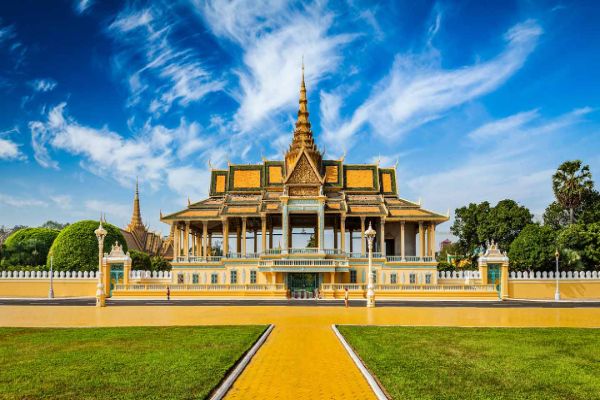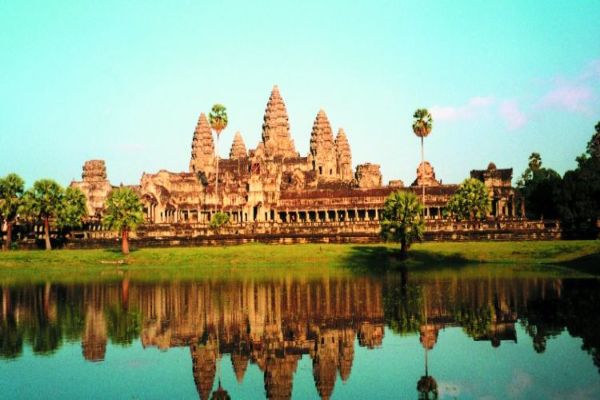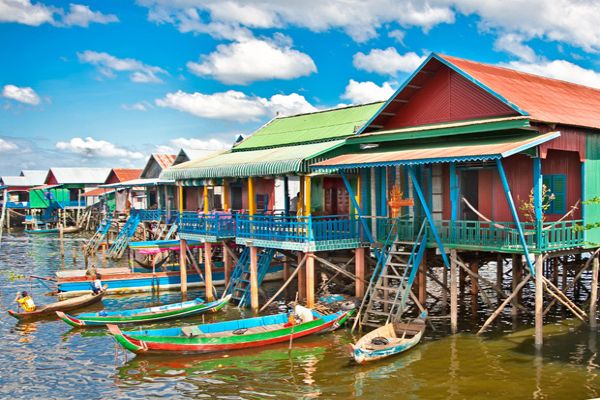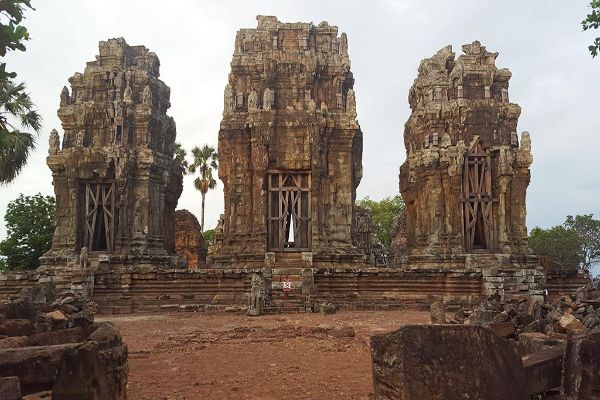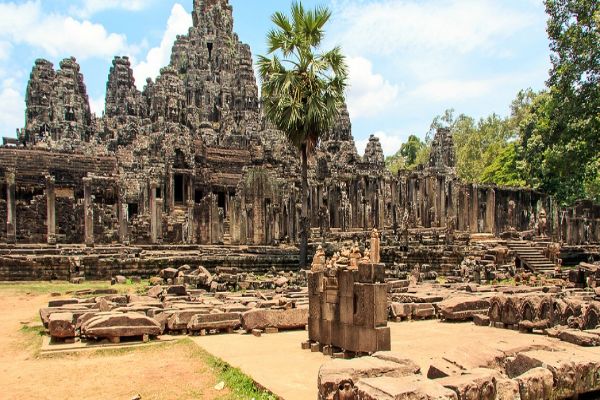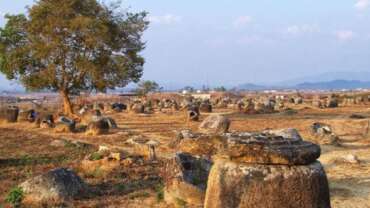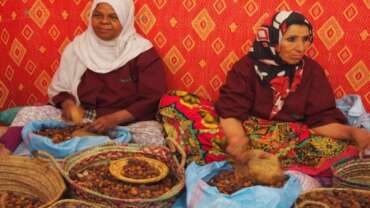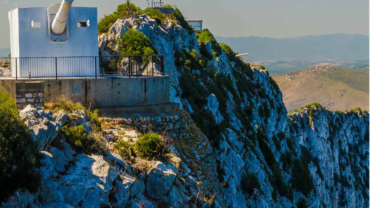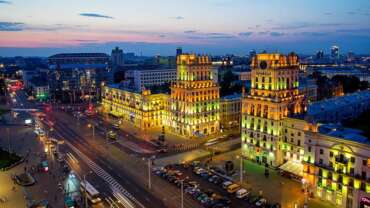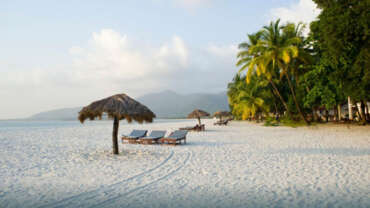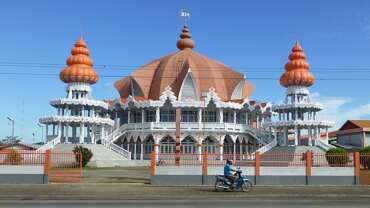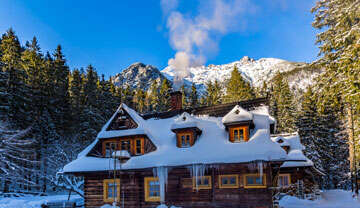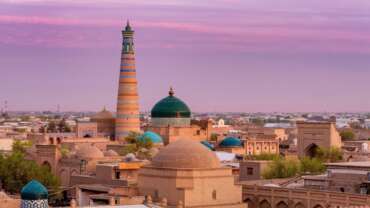MICE in Cambodia - Kingdom of wonder
Where can we host your conference in Asia?
Have you ever imagined creating a large event in Cambodia? Well rest assured that this is not an odd idea. Cambodia offers a wide variety of spots and venue to bring in your group or enterprise. From beautiful and exotic littoral zones to the immense and breath taking temples. We are positively sure your group will enjoy every moment in this wonderful Kingdom.
MEETINGS
Meet in a fascinating destination: Siem Reap, Phnom Penh and the South Coast offer endless possibilities for doing business in style. From low key and relaxed settings such as a championship golf course to meetings in historical hotels and restaurants all are easy to facilitate in Cambodia. The main destinations are Siem Reap and Phnom Penh but inspiring locations are also to be found in Kep and Sihanoukville. Whether simple or complicated the idea is to innovate in dynamic destinations that suit your business needs.
INCENTIVES
Motivate visitors by exceptional experiences – add local touches and flair to impress and incentivise the team. Reward your team or clients and provide motivation for the future in unique ways. Team building can involve house building or well construction to support poorer communities. Create challenges and Great Races, use local transport such as ox carts or bikes to see the countryside, Masterchef cook offs to test the team or less testing experiences such as spa and yoga to relax. Options such as helicopter tours or golf matches can incentivise guests and drive them to great achievement.
CONFERENCES
With flexibility and capability to fit business demands, conferences of all scales can be arranged in Cambodia. Located in the heart of Southeast Asia, the Kingdom of Cambodia is ideal for pre and post-conference leisure and team building. With a variety of venues, from understated board rooms to world class hotelsand convention centres with state of the art technology, an everyday meeting can be transformed into a memorable and enriching experience.
EVENTS
Unparalleled in Asia, few destinations can impress as much as Cambodia, with a temple gala dinner the highlight amongst multiple unique experiences. Unrivalled celebrations at iconic locations will last long in the memories of visitors to Cambodia. Imagine a gala dinner at an Angkorian temple or drinking a cocktail at a country house as the sun sets over the rice fields. Gala dinners at the National Museum or cocktails at the colonial-era train station are the ideal way to begin the evening after a day’s work. With a huge range of event options from simple sundowner cruises on a wooden boat to privatized temple dinners there is so much to offer your clients or team in Cambodia.
CSR & TEAM BUILDING
In a developing country there are plentiful options that give something back to Cambodia by way of CSR activities. Fun and games that bond your employees to the company and educate them in the value of team work can also be arranged. Help Cambodia by doing a CSR activity that gives something rewarding back to the country. Simple activities such as tree planting, painting a school, building vertical gardens and constructing bicycles for donation can be arranged. The more active might prefer to help construct a house in a poorer community. Supporting Cambodian arts and crafts can be arranged in local villages outside Phnom Penh or at an NGO silk farm near Siem Reap. Simple donations such as water wells or school kits can be channeled to good causes that are audited and won’t waste your good intentions. Team Building can be both fun and educational. Take part in an Amazing Race through local markets and the Siem Reap countryside and try your hand at Khmer martial arts or classical dance in Phnom Penh.
History of Cambodia
No one knows for certain how long people have lived in what is now Cambodia, as studies of its prehistory are undeveloped. A carbon-l4 dating from a cave in northwestern Cambodia suggests that people using stone tools lived in the cave as early as 4000 bc, and rice has been grown on Cambodian soil since well before the 1st century ad. The first Cambodians likely arrived long before either of these dates. They probably migrated from the north, although nothing is known about their language or their way of life.
By the beginning of the 1st century ad, Chinese traders began to report the existence of inland and coastal kingdoms in Cambodia. These kingdoms already owed much to Indian culture, which provided alphabets, art forms, architectural styles, religions (Hinduism and Buddhism), and a stratified class system. Local beliefs that stressed the importance of ancestral spirits coexisted with the Indian religions and remain powerful today.
Cambodia’s modem-day culture has its roots in the 1st to 6th centuries in a state referred to as Funan, known as the oldest Indianized state in Southeast Asia. It is from this period that evolved Cambodia’s language, part of the Mon-Khmer family, which contains elements of Sanskrit, its ancient religion of Hinduism and Buddhism. Historians have noted, for example, that Cambodians can be distinguished from their neighbors by their clothing – checkered scarves known as Kramas are worn instead of straw hats.
Funan gave way to the Angkor Empire with the rise to power of King Jayavarman II in 802. The following 600 years saw powerful Khmer kings dominate much of present day Southeast Asia, from the borders of Myanmar east to the South China Sea and north to Laos. It was during this period that Khmer kings built the most extensive concentration of religious temples in the world – the Angkor temple complex. The most successful of Angkor’s kings, Jayavarman II, Indravarman I, Suryavarman II and Jayavarman VII, also devised a masterpiece of ancient engineering: a sophisticated irrigation system that includes barays (gigantic man-made lakes) and canals that ensured as many as three rice crops a year. Part of this system is still in use today.
The Khmer Kingdom (Funan)
Early Chinese writers referred to a kingdom in Cambodia that they called Funan. Modern-day archaeological findings provide evidence of a commercial society centered on the Mekong Delta that flourished from the 1st century to the 6th century. Among these findings are excavations of a port city from the 1st century, located in the region of Oc-Eo in what is now southern Vietnam. Served by a network of canals, the city was an important trade link between India and China. Ongoing excavations in southern Cambodia have revealed the existence of another important city near the present-day village of Angkor Borei.
A group of inland kingdoms, known collectively to the Chinese as Zhenla, flourished in the 6th and 7th centuries from southern Cambodia to southern Laos. The first stone inscriptions in the Khmer language and the first brick and stone Hindu temples in Cambodia date from the Zhenla period.
Angkor Era
Bayon Temple, Angkor Thom The giant faces carved on the Bayon temple at the Angkor Thum complex in northwestern Cambodia represent both the Buddha and King Jayavarman VII (ruled about 1130-1219). Although a Buddhist temple, Angkor Thum was modeled after the great Hindu temple complex of Angkor Wat.
In the early 9th century a Khmer (ethnic Cambodian) prince returned to Cambodia from abroad. He probably arrived from nearby Java or Sumatra, where he may have been held hostage by island kings who had asserted control over portions of the Southeast Asian mainland.
In a series of ceremonies at different sites, the prince declared himself ruler of a new independent kingdom, which unified several local principalities. His kingdom eventually came to be centered near present-day Siemreab in northwestern Cambodia. The prince, known to his successors as Jayavarman II, inaugurated a cult honoring the Hindu god Shiva as a devaraja (Sanskrit term meaning “god-king”). The cult, which legitimized the king’s rule by linking him with Shiva, persisted at the Cambodian court for more than two hundred years.
Between the early 9th century and the early 15th century, 26 monarchs ruled successively over the Khmer kingdom (known as Angkor, the modern name for its capital city).
The successors of Jayavarman II built the great temples for which Angkor is famous.
Historians have dated more than a thousand temple sites and over a thousand stone inscriptions (most of them on temple walls) to this era.
Notable among the Khmer builder-kings were Suyavarman II, who built the temple known as Angkor Wat in the mid-12th century, and Jayavarman VII, who built the Bayon temple at Angkor Thum and several other large Buddhist temples half a century later. Jayavarman VII, a fervent Buddhist, also built hospitals and rest houses along the roads that crisscrossed the kingdom. Most of the monarchs, however, seem to have been more concerned with displaying and increasing their power than with the welfare of their subjects.
Ancient City of Angkor This map shows the layout of the ancient city of Angkor, capital of the Cambodian Khmer kingdom from the 9th century to the 15th century. The city’s huge stone temples were both civic centers and religious symbols of the Hindu cosmos. Historians believe that Angkor’s network of canals and barays (reservoirs) were used for irrigation.
At its greatest extent, in the 12th century, the Khmer kingdom encompassed (in addition to present-day Cambodia) parts of present-day Vietnam, Laos, Thailand, Myanmar (formerly Burma), and the Malay Peninsula. Thailand and Laos still contain Khmer ruins and inscriptions. The kings at Angkor received tribute from smaller kingdoms to the north, east, and west, and conducted trade with China. The capital city was the center of an impressive network of reservoirs and canals, which historians theorize supplied water for irrigation. Many historians believe that the abundant harvests made possible by irrigation supported a large population whose labor could be drawn on to construct the kings’ temples and to fight their wars. The massive temples, extensive roads and waterworks, and confident inscriptions give an illusion of stability that is undermined by the fact that many Khmer kings gained the throne by conquering their predecessors. Inscriptions indicate that the kingdom frequently suffered from rebellions and foreign invasions.
Historians have not been able to fully explain the decline of the Khmer kingdom in the 13th and 14th centuries. However, it was probably associated with the rise of powerful Thai kingdoms that had once paid tribute to Angkor, and to population losses following a series of wars with these kingdoms. Another factor may have been the introduction of Theravada Buddhism, which taught that anyone could achieve enlightenment through meritorious conduct and meditation. These egalitarian ideas undermined the hierarchical structure of Cambodian society and the power of prominent Hindu families. After a Thai invasion in 1431, what remained of the Cambodian elite shifted southeastward to the vicinity of Phnom Penh.
Cambodia Dark Age
This map of Southeast Asia in the mid-16th century shows the major centers of power in the region prior to the arrival of Europeans. During this period, these kingdoms were constantly at war. Eventually the Kingdom of Ayutthaya (modern Thailand) expanded to the north and east, absorbing much of Lan Na and Lan Xang (modern Laos). Dai Viet (modern Vietnam) expanded to the south, taking over the remaining territory of the Kingdom of Champa and the southern tip of the Kingdom of Lovek (modern Cambodia). Toungoo evolved into modern Myanmar.
The four centuries of Cambodian history following the abandonment of Angkor are poorly recorded, and therefore historians know little about them beyond the bare outlines. Cambodia retained its language and its cultural identity despite frequent invasions by the powerful Thai kingdom of Ayutthaya and incursions by Vietnamese forces. Indeed, for much of this period, Cambodia was a relatively prosperous trading kingdom with its capital at Lovek, near present-day Phnom Penh. European visitors wrote of the Buddhist piety of the inhabitants of the Kingdom of Lovek. During this period, Cambodians composed the country’s most important work of literature, the Reamker (based on the Indian myth of the Ramayana).
In the late 18th century, a civil war in Vietnam and disorder following a Burmese invasion of Ayutthaya spilled over into Cambodia and devastated the area. In the early 19th century, newly established dynasties in Vietnam and Thailand competed for control over the Cambodian court. The warfare that ensued, beginning in the l830s, came close to destroying Cambodia.
French Rule
Phnom Penh, as planned by the French, came to resemble a town in provincial France. By the second half of the 19th century, France had begun to expand its colonial penetration of Indochina (the peninsula between India and China). In 1863 France accepted the Cambodian king’s invitation to impose a protectorate over his severely weakened kingdom, halting the country’s dismemberment by Thailand and Vietnam. For the next 90 years, France ruled Cambodia. In theory, French administration was indirect, but in practice the word of French officials was final on all major subjects-including the selection of Cambodia’s kings. The French left Cambodian institutions, including the monarchy, in place, and gradually developed a Cambodian civil service, organized along French lines. The French administration neglected education but built roads, port facilities, and other public works. Phnom Penh, as planned by the French, came to resemble a town in provincial France.
The French invested relatively little in Cambodia’s economy compared to that of Vietnam, which was also under French control. However, they developed rubber plantations in eastern Cambodia, and the kingdom exported sizable amounts of rice under their rule. The French also restored the Angkor temple complex and deciphered Angkorean inscriptions, which gave Cambodians a clear idea of their medieval heritage and kindled their pride in Cambodia’s past. Because France left the monarchy, Buddhism, and the rhythms of rural life undisturbed, anti-French feeling was slow to develop.
King Sihanouk, through skillful maneuvering, managed to gain Cambodia’s independence peacefully in 1953. During World War II (1939-1945), Japanese forces entered French Indochina but left the compliant French administration in place.
On the verge of defeat in 1945, the Japanese removed their French collaborators and installed a nominally independent Cambodian government under the recently crowned young king, Norodom Sihanouk. France reimposed its protectorate in early 1946 but allowed the Cambodians to draft a constitution and to form political parties.
Soon afterward, fighting erupted throughout Indochina as nationalist groups, some with Communist ideologies, struggled to win independence from France. Most of the fighting took place in Vietnam, in a conflict known as the First Indochina War (1946-1954). In Cambodia, Communist guerrilla forces allied with Vietnamese Communists gained control of much of the country. However, King Sihanouk, through skillful maneuvering, managed to gain Cambodia’s independence peacefully in 1953, a few months earlier than Vietnam. The Geneva Accords of 1954, which marked the end of the First Indochina War, acknowledged Sihanouk’s government as the sole legitimate authority in Cambodia.
Modern State
Sihanouk’s campaign for independence sharpened his political skills and increased his ambitions. In 1955 he abdicated the throne in favor of his father to pursue a full-time political career, free of the constitutional constraints of the monarchy. In a move aimed at dismantling Cambodia’s fledgling political parties, Sihanouk inaugurated a national political movement known as the Sangkum Reastr Niyum (People’s Socialist Community), whose members were not permitted to belong to any other political group. The Sangkum won all the seats in the national elections of 1955, benefiting from Sihanouk’s popularity and from police brutality at many polling stations. Sihanouk served as prime minister of Cambodia until 1960, when his father died and he was named head of state. Sihanouk remained widely popular among the people but was brutal to his opponents.
In the late 1950s the Cold War (period of tension between the United States and its allies and the Union of Soviet Socialist Republics, or USSR, and its allies) intensified in Asia. In this climate, foreign powers, including the United States, the USSR, and China, courted Sihanouk. Cambodia’s importance to these countries stemmed from events in neighboring Vietnam, where tension had begun to mount between a Communist regime in the north and a pro-Western regime in the south. The USSR supported the Vietnamese Communists, while the United States opposed them, and China wanted to contain Vietnam for security reasons. Each of the foreign powers hoped that Cambodian support would bolster its position in the region. Sihanouk pursued a policy of neutrality that drew substantial economic aid from the competing countries.
In 1965, however, Sihanouk broke off diplomatic relations with the United States. At the same time, he allowed North Vietnamese Communists, then fighting the Vietnam War against the United States and the South Vietnamese in southern Vietnam, to set up bases on Cambodian soil. As warfare intensified in Vietnam, domestic opposition to Sihanouk from both radical and conservative elements increased. The Cambodian Communist organization, known as the Workers Party of Kampuchea (later renamed the Communist Party of Kampuchea, or CPK), had gone underground after failing to win any concessions at the Geneva Accords, but now they took up arms once again. As the economy became unstable, Cambodia became difficult to govern single-handedly. In need of economic and military aid, Sihanouk renewed diplomatic relations with the United States. Shortly thereafter, in 1969, U.S. president Richard Nixon authorized a bombing campaign against Cambodia in an effort to destroy Vietnamese Communist sanctuaries there.
Khmer Republic
In March 1970 Cambodia’s legislature, the National Assembly, deposed Sihanouk while he was abroad. The conservative forces behind the coup were pro-Western and anti-Vietnamese. General Lon Nol, the country’s prime minister, assumed power and sent his poorly equipped army to fight the North Vietnamese Communist forces encamped in border areas. Lon Nol hoped that U.S. aid would allow him to defeat his enemies, but American support was always geared to events in Vietnam. In April U.S. and South Vietnamese troops invaded Cambodia, searching for North Vietnamese, who moved deeper into Cambodia. Over the next year, North Vietnamese troops destroyed the offensive capacity of Lon Nol’s army.
In October 1970 Lon Nol inaugurated the Khmer Republic. Sihanouk, who had sought asylum in China, was condemned to death despite his absence. By that time, Chinese and North Vietnamese leaders had persuaded the prince to establish a government in exile, allied with North Vietnam and dominated by the CPK, whom Sihanouk referred to as the Khmer Rouge (French for “Red Khmers”).
In 1975, despite massive infusions of U.S. aid, the Khmer Republic collapsed, and Khmer Rouge forces occupied Phnom Penh.
The United States continued bombing Cambodia until the Congress of the United States halted the campaign in 1973. By that time, Lon Nol’s forces were fighting not only the Vietnamese but also the Khmer Rouge. The general lost control over most of the Cambodian countryside, which had been devastated by U.S. bombing. The fighting severely damaged the nation’s infrastructure and caused high numbers of casualties. Hundreds of thousands of refugees flooded into the cities. In 1975, despite massive infusions of U.S. aid, the Khmer Republic collapsed, and Khmer Rouge forces occupied Phnom Penh. Three weeks later, North Vietnamese forces achieved victory in South Vietnam.
Democratic Kampuchea
Pol Pot Pol Pot is a pseudonym for the Cambodian guerrilla commander Saloth Sar, who organized the Communist guerrilla force known as the Khmer Rouge. The Khmer Rouge ousted General Lon Nol in 1975, establishing a brutal Communist regime that ruled until 1979.
Immediately after occupying Cambodia’s towns, the Khmer Rouge ordered all city dwellers into the countryside to take up agricultural tasks. The move reflected both the Khmer Rouge’s contempt for urban dwellers, whom they saw as enemies, and their utopian vision of Cambodia as a nation of busy, productive peasants. The leader of the regime, who remained concealed from the public, was Saloth Sar, who used the pseudonym Pol Pot. The government, which called itself Democratic Kampuchea (DK), claimed to be seeking total independence from foreign powers but accepted economic and military aid from its major allies, China and North Korea.
Khmer Rouge Carnage The Khmer Rouge, led by Pol Pot, killed close to 1.7 million people in the mid- to late 1970s. In this photo, human bones and skulls fill a museum in Cambodia that had been used as a prison and torture center during Pol Pot’s reign, Sygma.
Without identifying themselves as Communists, the Khmer Rouge quickly introduced a series of far-reaching and often painful socialist programs. The people given the most power in the new government were the largely illiterate rural Cambodians who had fought alongside the Khmer Rouge in the civil war. DK leaders severely restricted freedom of speech, movement, and association, and forbade all religious practices. The regime controlled all communications along with access to food and information. Former city dwellers, now called “new people,” were particularly badly treated. The Khmer Rouge killed intellectuals, merchants, bureaucrats, members of religious groups, and any people suspected of disagreeing with the party. Millions of other Cambodians were forcibly relocated, deprived of food, tortured, or sent into forced labor.
While in power, the Khmer Rouge murdered, worked to death, or killed by starvation close to 1.7 million Cambodians.
The Khmer Rouge also attacked neighboring countries in an attempt to reclaim territories lost by Cambodia many centuries before. After fighting broke out with Vietnam (then united under the Communists) in 1977, DK’s ideology became openly racist. Ethnic minorities in Cambodia, including ethnic Chinese and Vietnamese, were hunted down and expelled or massacred. Purges of party members accused of treason became widespread. People in eastern Cambodia, suspected of cooperating with Vietnam, suffered severely, and hundreds of thousands of them were killed. While in power, the Khmer Rouge murdered, worked to death, or killed by starvation close to 1.7 million Cambodians-more than one-fifth of the country’s population.
Recent Development
In October 1991 Cambodia’s warring factions, the UN, and a number of interested foreign nations signed an agreement in Paris intended to end the conflict in Cambodia. The agreement provided for a temporary power-sharing arrangement between a United Nations Transitional Authority in Cambodia (UNTAC) and a Supreme National Council (SNC) made up of delegates from the various Cambodian factions. Prince Norodom Sihanouk, the former king and prime minister of Cambodia, served as president of the SNC.
The Paris accords and the UN protectorate pushed Cambodia out of its isolation and introduced competitive politics, dormant since the early 1950s. UNTAC sponsored elections for a national assembly in May 1993, and for the first time in Cambodian history a majority of voters rejected an armed, incumbent regime. A royalist party, known by its French acronym FUNCINPEC, won the most seats in the election, followed by the CPP, led by Hun Sen. Reluctant to give up power, Hun Sen threatened to upset the election results. Under a compromise arrangement, a three-party coalition formed a government headed by two prime ministers; FUNCINPEC’s Prince Norodom Ranariddh, one of Sihanouk’s sons, became first prime minister, while Hun Sen became second prime minister.
In September 1993 the government ratified a new constitution restoring the monarchy and establishing the Kingdom of Cambodia. Sihanouk became king for the second time. After the 1993 elections, no foreign countries continued to recognize the DK as Cambodia’s legal government. The DK lost its UN seat as well as most of its sources of international aid.
The unrealistic power-sharing relationship between Ranariddh and Hun Sen worked surprisingly well for the next three years, but relations between the parties were never smooth. The CPP’s control over the army and the police gave the party effective control of the country, and it dominated the coalition government. In July 1997 Hun Sen staged a violent coup against FUNCINPEC and replaced Prince Ranariddh, who was overseas at the time, with Ung Huot, a more pliable FUNCINPEC figure. Hun Sen’s action shocked foreign nations and delayed Cambodia’s entry into the Association of Southeast Asian Nations (ASEAN). By the end of 1997, Cambodia was the only nation in the region that was not a member.
Despite the coup, elections scheduled for July 1998 proceeded as planned. Hundreds of foreign observers who monitored the elections affirmed that voting was relatively free and fair; however, the CPP harassed opposition candidates and party workers before and after the elections, when dozens were imprisoned and several were killed. The election gave the CPP a plurality of votes, but results, especially in towns, where voting could not be dictated by local authorities, indicated that the party did not enjoy widespread popular support. Prince Ranariddh and another opposition candidate, Sam Rainsy, took refuge abroad and contested the outcome of the election. In November the CPP and FUNCINPEC reached an agreement whereby Hun Sen became sole prime minister and Ranariddh became president of the National Assembly. The parties formed a coalition government, dividing control over the various cabinet ministries. In early 1999 the constitution was amended to create a Senate, called for in the 1998 agreement. These signs that Cambodia’s political situation was stabilizing encouraged ASEAN to admit Cambodia to its membership a short time later.
Pol Pot died in 1998, and by early 1999 most of the remaining Khmer Rouge troops and leaders had surrendered. Rebel troops were integrated into the Cambodian army. In 1999 two Khmer Rouge leaders were arrested and charged with genocide for their part in the atrocities.
Since the Paris Accords of 1991, Cambodia’s economic growth has depended on millions of dollars of foreign aid. Foreign interest in Cambodia has decreased, however, and the country has received diminishing economic assistance. This development, along with the continued lack of openness in Cambodian politics, has made Cambodia’s prospects for democratization dim, as well as its chances for sustained economic growth.
People of Cambodia
Ethnic Composition
The population of Cambodia today is about 10 million. About 90-95 percent of the people are Khmer ethnic. The remaining 5-10 percent include Chinese-Khmers, Khmer Islam or Chams, ethnic hill-tribe people, known as the Khmer Loeu, and Vietnamese. About 10 percent of the population lives in Phnom Penh, the capital, making Cambodia largely a country of rural dwellers, farmers and artisans.
The ethnic groups that constitute Cambodian society possess a number of economic and demographic commonalties- for example. Chinese merchants lived mainly in urban centers and play middlemen in many economic cycles, but they also preserve differences in their social and cultural institutions. They were concentrated mostly in central and in southeastern Cambodia, the major differences among these groups lie in social organization, language, and religion.
The majority of the inhabitants of Cambodia are settled in fairly permanent villages near the major bodies of water in the Tonle Sap Basin-Mekong Lowlands region. The Khmer Loeu live in widely scattered villages that are abandoned when the cultivated land in the vicinity is exhausted. The permanently settled Khmer and Cham villages usually located on or near the banks of a river or other bodies of water. Cham villages usually are made up almost entirely of Cham, but Khmer villages, especially in central and in southeastern of Cambodia, typically include sizable Chinese communities.
The Khmer Loeu
The Khmer Loeu are the non-Khmer highland tribes in Cambodia. The Khmer Loeu are found namely in the northeastern provinces of Rattanakiri, Stung Treng, Mondulkiri and Crate. Most Khmer Loeu live in scattered temporary villages that have only a few hundred inhabitants. These villages usually are governed by a council of local elders or by a village headman.
The Khmer Loeu cultivate a wide variety of plants, but the man crop is dry or upland rice growth by the slash-and-burn method. Hunting, fishing, and gathering supplement the cultivated vegetable foods in the Khmer Loeu diet.
Houses vary from huge multi-family long houses to small single family structures. They may be built close to the ground or on stilts. The major Khmer Loeu groups in Cambodia are the Kuy, Phnong, Brao, Jarai, and Rade. All but about 160,000 Kuy lived in the northern Cambodia provinces of Kampong Thom, Preah Vihear, and Stoeng as well as in adjacent Thailand.
The Cham
The Cham people in Cambodia descend from refugees of the Kingdom of Champa, which one ruled much of Vietnam between Gao Ha in the north and Bien Hao in the south.
The Cambodian Chams are divided into two groups, the orthodox and the traditional- base on their religious practices. The orthodox group, which make up about one-third of the total number of Chams in the country, were located mainly in Phnom Penh – Oudong area and in the provinces of Takeo and Kapot.
The traditional Chams were scattered throughout the midsection of the country in the provinces of Battambang, Kompong Thom, Kompong Cham, and Pursat. The Chams of both groups typically live in villages inhabited only by other Chams; the villages may be along the shores of watercourses, or they may be inland. The inhabitants of the river villages engage in fishing and growing vegetables. They trade fish to local Khmer for rice.
The women in these villages earn money by weaving. The Chams who live inland support themselves by various means, depending on the villages. Some villages specialize in metalworking; others raise fruit trees or vegetables. The Chams also often serve as butchers of cattle for their Khmer Buddhist neighbors and are, in some areas, regarded as skillful water buffalo and ram breeders.
The Chinese
The Chinese in Cambodia formed the country es largest ethnic minority. Sixty percent of the Chinese were urban dwellers engaged mainly in commerce; the other 40 percent were rural residents working as shopkeepers, as buyers and processors of rice, palm sugar, fruit, and fish, and as money lenders.
It is estimated that 90 percent of the Chinese in Cambodia were in commerce and that 92 percent of those involved in commerce in Cambodia were Chinese. In rural Cambodia, the Chinese were moneylenders, and they wielded considerable economic power over the ethnic Khmer peasants through usury.
The Chinese in Cambodia represented five major linguistic groups, the largest of which was the Teochiu (accounting about 60 percent), followed by the Cantonese (accounting about 20 percent), the Hokkien (accounting about 7 percent), and the Hakka and the Hainanese (each accounting for 4 percent). Those belonging to the certain Chinese linguistic groups in Cambodia tended to gravitate to certain occupations.
The Teochiu, who make up about 90 percent of the rural Chinese population, ran village stores, control rural credit and rice marketing facilities, and grew vegetables. In urban areas they were often engaged in such enterprises as the import-export business, the sale of pharmaceuticals, and street peddling. The Cantonese, who were the majority of Chinese groups before Teochiu migrations began in the late 1930s, live mainly in the city. Typically, the Cantonese engages in transportation and in constriction, for the most part as mechanics or carpenters.
The Hokkien community was involved import-export and in banking, and it included some of the countryfs richest Chinese. The Hainanese started out as pepper growers in Kompot Province, where they continued to dominate that business. Many moved to Phnom Penh , where, in the late 1960s, they reportedly had virtual monopoly on the hotel and restaurant business. They also often operated tailor shops. In Phnom Penh, the newly arrived Hakka were typically folk dentists, sellers of traditional Chinese medicines, and shoemakers.
The Vietnamese
The Vietnamese community is scattered throughout southeastern and central Cambodia. They were concentrated in Phnom Penh, and in Kandal, Prey Veng, and Kampong Cham provinces. No close cultural or religious ties exist between Cambodia and Vietnam.
The Vietnamese fall within the Chinese culture sphere, rather within the Indian, where the Thai and Khmer belong. The Vietnamese differ from the Khmer in mode of dress, in kinship organization, and in many other ways- for example the Vietnamese are Mahayama Buddhists while most of the Cambodians are Theravada Buddhists. Although Vietnamese lived in urban centers such as Phnom Penh, a substantial number lived along the lower Mekong and Bassac rivers as well as on the shores of the Tonle Sap, where they engaged in fishing.
Art & Culture of Cambodia
The lines of culture distinguishing one country from another are blurring. The globalization of technology, information and finance has allowed wealthy countries to export not only their political and economic ideologies to developing countries but their traditions and values as well.
The Cambodian government has made aggressive rhetorical efforts to preserve the integrity of traditional Khmer culture, but younger generations are hungry for a change.
In a seemingly uphill battle to maintain cultural identity in an increasingly homogeneous global community, one man has made it his mission to preserve the past for future generations.
From household items and clothes to jewelry and sculpture, Liv Saa Em’s private collection is one of the largest in Cambodia. “It is my favorite thing to do since I was young. I like to keep antiques in my house because my parents bought a lot of antiques from villagers to keep at their house.
Upon first glance, Liv Saa Em could be mistaken for an ancient Khmer man in his traditional dress. Ancient relics adorn his house as well, stretching from the front door into the darkest corners. The building is his sanctuary; a place Liv Saa Em says keeps him smiling. Visitors to the house, which doubles as a museum, often have offered the collector money for his goods. But Liv Saa Em’s mission is to maintain Khmer culture for Cambodia. His message: History is not for sale.
The robbery of Khmer artifacts, for sale to foreign countries, is a rising concern. In efforts to preserve the integrity of Cambodia’s tangible history, the Ministry of Culture and Fine Arts recently prohibited the exportation of artifacts from Cambodia to Vietnam and Thailand. Liv Saa Em agrees with the act’s passage, as he too works to preserve artifacts so that all of Cambodia may enjoy them in years to come.
Since the tender age of 13, Liv Saa Em has taken the cue of his parents, who were avid collectors. Now preserving artifacts is not only a hobby–it’s a mission. “I’m very upset when I see our artifacts exported to neighboring countries,” he said. “We know that they are really Khmer artifacts, but I have no ability to take them back to the country.”
Even when it is not in transit, safeguarding art is not always easy. Liv Saa Em said artifacts kept in the National Museum cannot be promised security, and his house in Tang Yab, Prey Kabas district of Takeo province is no better. Pieces of history were shattered in 1976 when young Khmer Rouge soldiers destroyed his parents’ house and the artifacts in it.
Unable to forget the loss, Liv Saa Em has made a conscious effort to buy pieces for his private collection at home. Trading medicine or rice for art, the collector has purchased relics from Takeo, Kampong Speu and Phnom Penh. Now Liv Saa Em’s reputation for collecting precedes him, and tourists that visit his home hoping to make a purchase are always denied.
“I love Khmer artifacts and I love to keep them forever,” Liv Saa Em said.
Liv Saa Em’s love affair with the past started when he was just a boy. “I wore simple cloth like other people when I was young,” he said. But after completing his studies, Liv Saa Em developed a style of his own. Entering adulthood, he wore the ancient Khmer cloth donned by people of the Funan period and shaved his head so that only a tuft of hair sat atop the middle of his crown.
Businessmen raised Liv Saa Em, the youngest son of a nine-member family that often dressed in traditional Khmer clothing. He was the most beloved of the lot then. Today he is alone. Liv Saa Em’s brothers, sisters and parents perished during the war.
Struggling to overcome the loss of his family, Liv Saa Em filled his time honing his skills as a silk maker. He mixes together a rainbow of colors to produce the vibrant fabric that is exported to Japan today and earned him the Ministry of Culture and Fine Arts’ Award for Best Quality Producing in 1993. His Excellency Nut Narang, the former Minister of Culture and Fine Arts, personally recognized Liv Saa Em as the first successful producer of best quality silk following Pol Pot’s regime. His creativity is unceasing. Liv Saa Em rearranges the relics in his house to assume a new look every week. In the afternoon visitors can find the collector sitting amidst his artifacts, which he says are a comfort to him. The house, an increasingly popular tourist destination, has drawn curious visitors from around the country and the world. Movie production companies have made the trip as well, using his traditional house for the backdrop to particular scenes.
Liv Saa Em preserves the past to protect the future. Concerned that irresponsible development could damage ancient artifacts, the collector suggested that Cambodia develop a tourism industry based on the riches of Khmer artifacts and temples.
Religion in Cambodia
Thearavada Buddhism is the official religion in Cambodia which is practiced by 95 percent of the population– just like that of Thailand, Burma, Sri Lanka. However, Christianity and Cham Muslim are being active and popular among a large number of population as well in the capital and provinces, showing a sign of growth. Daoism and Confuism are also commonly practiced among the Chinese people.
Buddhist monks are highly disciplined and must follow 227 rules in addition to the ten basic precepts of being a good Buddhist. Monks cannot take part in entertainment. They lead simple lives dedicated to Buddhism and the temple.
Buddhists see the universe and all life as part of a cycle of eternal change. They follow the teaching of Buddha, an Indian prince born in the sixth century B.C. Buddhists believe that a person is continually reborn, in human or nonhuman form, depending on his or her actions in a previous life. They are released from this cycle only when thy reach nirvana, which may be attained by achieving good karma through earning merit and following the Buddhist path of correct living.
Earning merit is an important of Buddhist life. Buddhists in Cambodia earn merit by giving money, goods, and labor to the temples, or by providing one of the two daily meals of the monks.
Children often look after the fruits trees and vegetable gardens inside their local wat, or temple. Boys can earn merit by becoming temple servants or novice monks for a short time. Most young men remain monks for less than a year.
Food & Drinks
Khmer food is one of the major national identities that reflect the ways of life, thought, and mind of the Cambodian people which are hidden in the taste of consumption of meat dishes and sweet food. Cambodia has been rich in a variety of plants and crops since ancient times so that we could cook many types of foods suitable for each group of different people.
Food is one of our most basic needs. We cannot live without it. Food gives us the energy for everything we do – walking, talking, working, playing, reading, and even thinking and breathing. Food also provides the energy for our nerves, muscles, heart, and glands that need to work. In addition, food supplies the nourishing substances to our bodies requiring to build and repair tissues and to regulate body organs and systems.
All living things must have food to live. Green plants use the energy of sunlight to make food out of carbon dioxide (a gas in the air) and water and other substances from the soil. Other living things depend on the food made by green plants. The food that people and other animals eat comes chiefly from plants or from animals that eat plants. Food does more than help keep us alive, strong, and healthy. It also adds pleasure to living. We enjoy the flavors, odors, colors, and textures of foods.
We celebrate special occasions with favorite meals and feasts. Favorite vegetables include beans, broccoli, cabbage, carrots, celery, lettuce, onions, peas, potatoes, and sweet corn. Vegetables are commonly eaten during the main part of a meal. They may be served raw in a salad, cooked and served with a sauce, or added to a soup.




